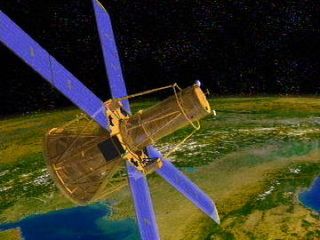Sun-Watching Spacecraft Sees 40,000 Solar Flares in 10 Years

One of NASA's workhorse space observatories, the RHESSI satellite, is celebrating its tenth year in space on a prolific sun-monitoring mission that has recorded more than 40,000 X-ray solar flares from our nearest star.
RHESSI, or the Ramaty High Energy Solar Spectroscopic Imager, hit its 10-year orbital milestone on Sunday (Feb. 5), NASA officials said. The observatory has been tracking solar flares to help astronomers better understand how the sun ejects huge amounts of particles and energy so efficiently.
During a solar eruption, intense magnetic activity causes areas around darkened patches, called sunspots, to emit energy in a solar flare. Some of that energy is in the form of X-rays, which can't penetrate Earth's atmosphere, so must be observed from space.
Flares often also release clouds of charged particles out into space called coronal mass ejections (CMEs). [Photos: Huge Sun Flare Sparks Radiation Storm]
"Except, thanks in part to RHESSI, we don't even separate the biggest explosions into categories like that anymore," Brian Dennis, the mission scientist for RHESSI at NASA's Goddard Space Flight Center in Greenbelt, Md., said in a statement. "RHESSI has taught us that 'Thou shalt instead say Solar Eruptive Events.' Now we know that one burst of energy in the sun’s atmosphere creates both kinds of eruptions. Part of the energy shoots into the sky and becomes a CME (coronal mass ejection). Part of the material is driven down to the sun’s surface and appears as the flare. RHESSI's 10 years of observations have helped fill in the holes in this picture."
RHESSI carries an instrument that records high-energy X-ray and gamma-ray light. During a solar flare, RHESSI maps out where energy moves and how energy levels change to understand the mechanics of the sun.

In a surprise, the observatory discovered that X-rays and gamma-rays were being emitted from different areas of the sun during a flare, offering clues to how radiation of different energies, related to different types of particles, is released. Scientists think X-rays are associated with electron activity, while gamma-rays come from protons and charged particles called ions.
Get the Space.com Newsletter
Breaking space news, the latest updates on rocket launches, skywatching events and more!
"This opens up new questions for our model," Dennis said. "The electrons and ions have different masses, but we'd still expect them to appear at the same locations in the flare. Perhaps the ions are accelerated in a different way and end up traveling on different magnetic field lines from the electrons."
Though RHESSI has already accumulated heaps of data, its work is not yet done. The spacecraft received a mission extension in 2009, and is still going strong.
The sun is currently coming out of a slumber and ramping up toward a period of maximum activity in 2013. This epoch should bring many more flares, and many more opportunities for RHESSI to study our nearest star.
The mission is named after Reuven Ramaty, a deceased NASA scientist who had long championed the project.
Follow SPACE.com for the latest in space science and exploration news on Twitter @Spacedotcom and on Facebook.
Join our Space Forums to keep talking space on the latest missions, night sky and more! And if you have a news tip, correction or comment, let us know at: community@space.com.

Space.com is the premier source of space exploration, innovation and astronomy news, chronicling (and celebrating) humanity's ongoing expansion across the final frontier. Originally founded in 1999, Space.com is, and always has been, the passion of writers and editors who are space fans and also trained journalists. Our current news team consists of Editor-in-Chief Tariq Malik; Editor Hanneke Weitering, Senior Space Writer Mike Wall; Senior Writer Meghan Bartels; Senior Writer Chelsea Gohd, Senior Writer Tereza Pultarova and Staff Writer Alexander Cox, focusing on e-commerce. Senior Producer Steve Spaleta oversees our space videos, with Diana Whitcroft as our Social Media Editor.











